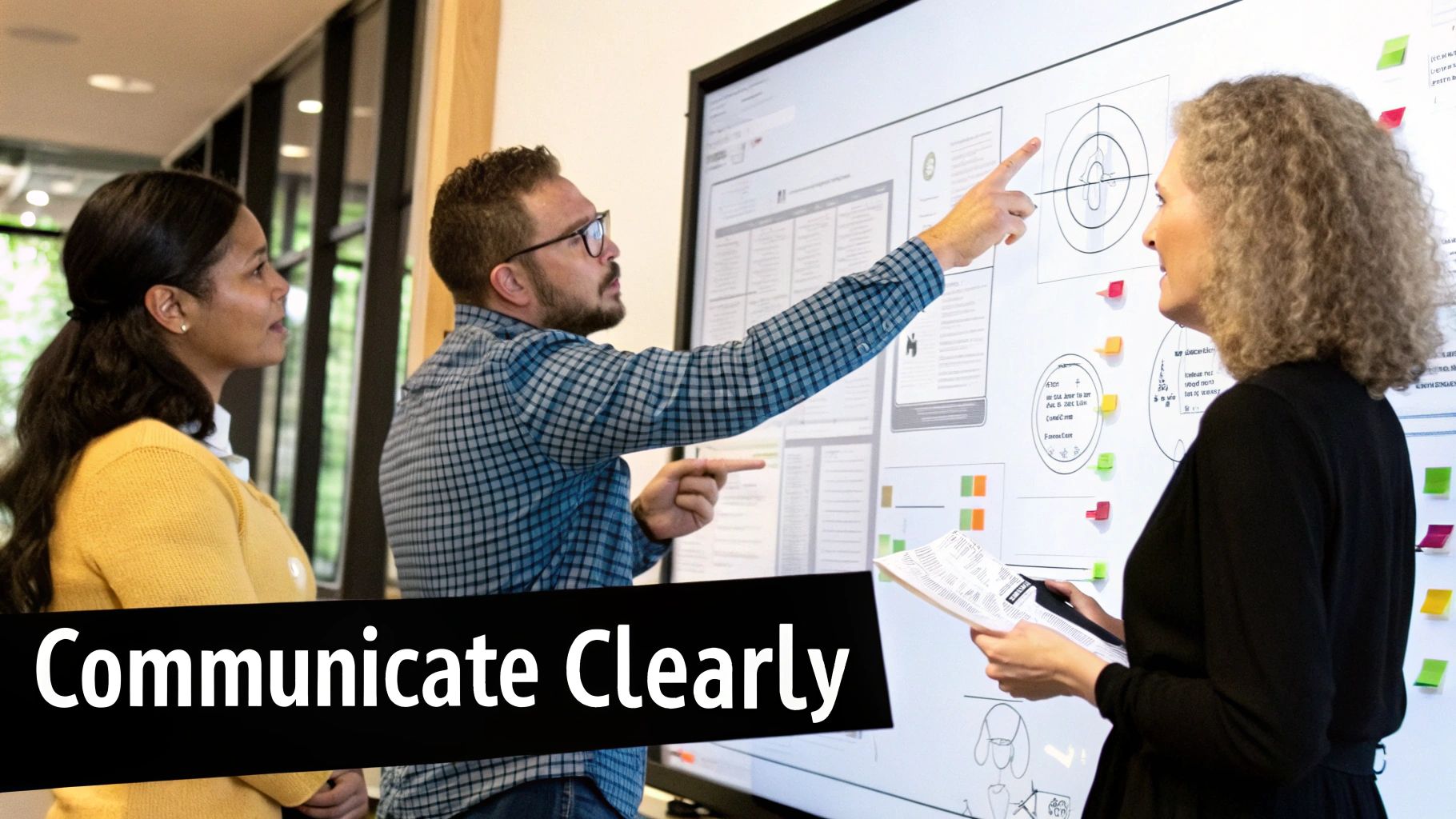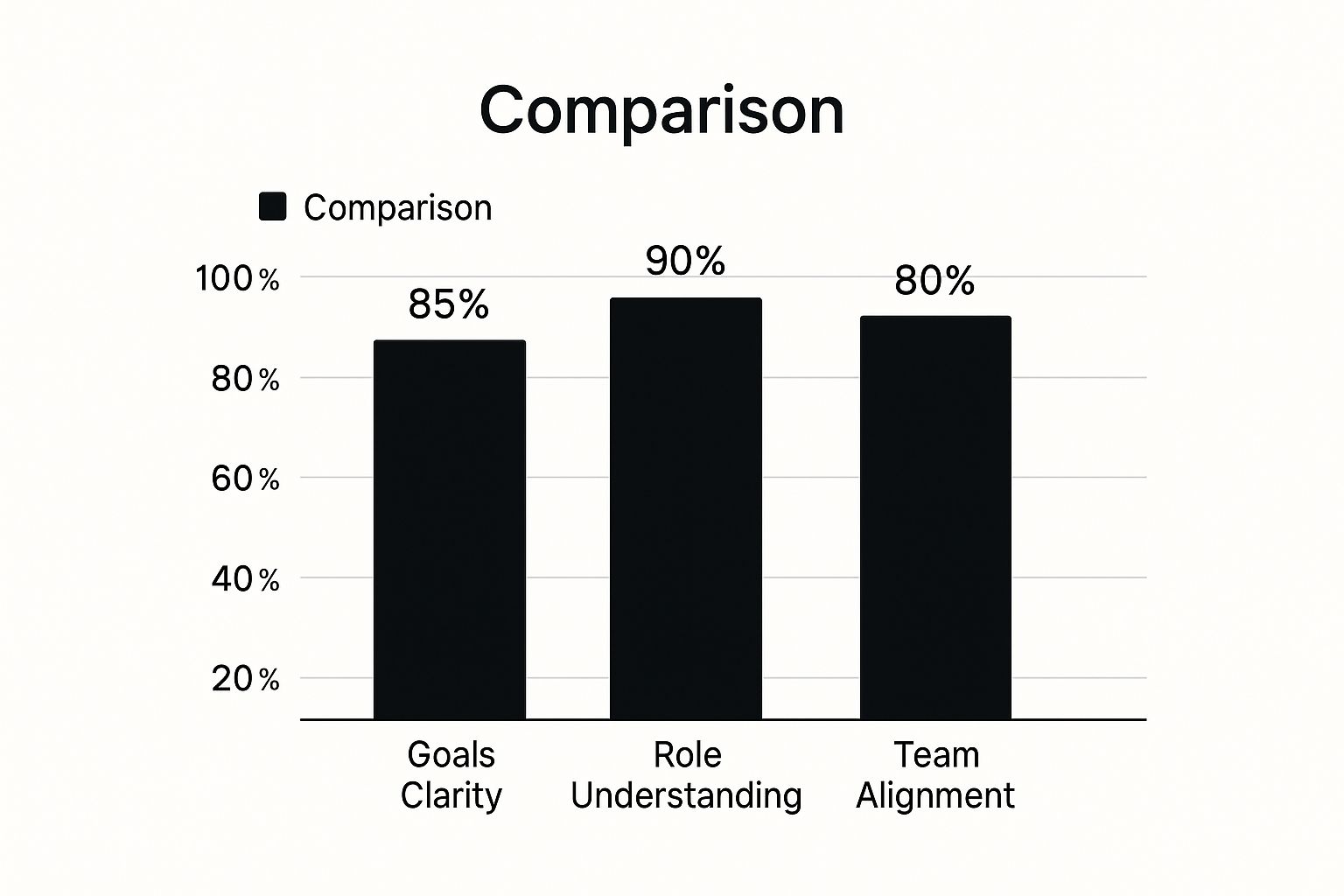So, how do you actually get your team to work better together? It’s not about trust falls or generic rah-rah speeches. Real improvement comes from building a solid foundation.
I've found that the best teams are built on three core pillars: shared goals, clear communication, and mutual trust. When you nail these, you stop having a group of individuals and start having a high-performing unit.
Building the Foundation of Great Teamwork
Let’s be honest, exceptional teamwork doesn't just happen by magic. It’s built, piece by piece, with intention.
It all starts when a team operates from a shared sense of purpose. When every single person understands how their individual tasks push the entire group forward, something clicks. This alignment is your North Star—it guides every decision and makes sure everyone is pulling in the same direction.
A huge part of this is setting crystal-clear expectations and defining what success looks like, often by setting effective Key Performance Indicators (KPIs). Once those goals are out in the open, it almost forces communication to get better.
A team is not a group of people who work together. A team is a group of people who trust each other.
That quote from Simon Sinek hits the nail on the head. Trust is the glue. It creates a space where people feel safe enough to take risks, throw out a wild idea, or even admit they made a mistake without fearing backlash. Without that psychological safety, you’ll never get true collaboration or innovation. Getting these elements right is one of the most crucial factors for ensuring project success.
The payoff here is massive. Don’t just take my word for it—research shows that companies that deliberately foster collaboration are five times more likely to be high-performing. Great teamwork can even boost productivity by around 25% because a tight-knit team naturally plays to each other's strengths and covers any weaknesses.
To help you get started, I've broken down these pillars into a simple framework. Think of it as your roadmap.
Core Pillars of Effective Teamwork
Here’s a quick summary of the fundamental components you need to build a high-performing team and the key actions that will get you there.
| Pillar | Key Action | Expected Outcome |
|---|---|---|
| Shared Goals | Define and communicate a clear, collective mission for every project. | Increased alignment, motivation, and focus on collective success. |
| Clear Communication | Establish open, honest, and regular channels for feedback and updates. | Reduced misunderstandings, faster problem-solving, and stronger bonds. |
| Mutual Trust | Encourage vulnerability, transparency, and dependable follow-through. | Enhanced psychological safety, more innovation, and greater team resilience. |
Focusing on these three areas isn't just a "nice-to-have." It's the practical, hands-on work that turns a good team into a great one.
Mastering Communication for Seamless Collaboration

Let’s be honest. Telling a team to “communicate better” is about as useful as telling a chef to “cook better.” It’s a nice thought, but it’s completely unhelpful. The real secret to unlocking better teamwork isn't about sending more messages or having more meetings. It’s about raising the quality of every single interaction. This means getting specific and practical.
The stakes are higher than you might think. A whopping 97% of employees and executives believe lackluster teamwork torpedoes project outcomes. Even more telling, 86% point directly to communication breakdowns as the culprit for major workplace failures.
But here’s the good news: getting this right can slash those distracting internal emails by as much as 30%. Think about that.
Define Clear Communication Channels
I've seen it a thousand times. Total chaos erupts because nobody knows where to have a conversation. Should that project update be a quick Slack message? An email? A comment in Asana? When there are no rules, important details get buried, and people get frustrated. Fast.
You can fix this by setting up a simple playbook for your communication tools. It’s all about creating consistency and cutting down on the mental guesswork.
Here's a simple breakdown I recommend:
- Instant Messaging (Slack, Teams, etc.): This is your go-to for urgent, quick-fire questions that need an answer now. It’s also great for the informal team banter that actually builds camaraderie.
- Email: Keep this for formal announcements, anything going to an external partner, or for sharing information that needs a paper trail but isn't time-sensitive.
- Project Management Tools (Asana, Jira, etc.): This is mission control. All task-specific updates, feedback, and questions should live right here, attached to the work itself.
When everyone knows where to look and where to post, collaboration starts to feel effortless instead of exhausting.
Practice Active Listening and Constructive Feedback
Real communication is a two-way street. It’s as much about listening as it is about talking. And I don’t mean just waiting for your turn to speak. I mean active listening—genuinely trying to understand the other person’s point of view before you even think about responding.
A great way to do this is to summarize what you heard. Something as simple as, “Okay, so if I’m hearing you right, your main concern is…” can work wonders.
Giving and receiving feedback is the other side of this coin. Good feedback is always about the work, not the person. It needs to be specific, objective, and focused on behavior.
Key Takeaway: I always coach teams to use the "Situation-Behavior-Impact" model. Instead of a vague, unhelpful comment like, "You were really quiet in that meeting," try this instead: "In this morning's brainstorm (Situation), I noticed you didn't jump in with any ideas (Behavior). I'm worried we might be missing out on your perspective (Impact)."
See the difference? It takes the personal judgment out of it and opens the door for a real conversation. It’s a fundamental skill, and it’s especially critical when dealing with clients and stakeholders—a cornerstone of the client communication best practices we live by.
When you master these skills, dialogue stops being a source of conflict and becomes your team’s most powerful tool for getting things done.
Cultivating Trust and Psychological Safety

Let's talk about the invisible engine of a high-performing team: trust.
When it’s there, everything just clicks. Communication flows, ideas are shared freely, and people have each other's backs. When it’s missing? Everything grinds to a halt. Building it isn't a one-and-done workshop; it’s an ongoing commitment to creating an environment of psychological safety.
What does that actually mean? Psychological safety is the shared belief that your team is a safe place to take risks. It’s the freedom to speak up, challenge an idea, or admit you screwed up without fearing you'll be humiliated or punished for it.
Think of it as the bedrock. Without it, you get silence, surface-level agreement, and a total lack of innovation because everyone is playing defense.
Lead With Vulnerability and Transparency
Trust, more often than not, starts at the top. When leaders are willing to be vulnerable—admitting they don't have an answer or sharing a past failure—it sends a powerful signal to the whole team: it's okay to be human here.
I’ve seen this completely shift a team's dynamic. A project manager might start a kickoff meeting by saying, "Honestly, this deadline is tight, and I'm not 100% sure how we'll hit it. I need everyone's best ideas on this." That simple admission invites genuine problem-solving instead of just projecting false confidence.
Transparency is the other side of that coin. You have to keep your team in the loop on big decisions, changes in direction, and company performance—even when the news isn't great. Shielding people from the truth just creates an information vacuum that they’ll fill with their own anxieties and worst-case scenarios.
Key Insight: True team resilience isn’t about never facing setbacks. It’s about having a foundation of trust so strong that the team can navigate those setbacks together, openly and without blame.
Empower With Autonomy and Mutual Support
Want to kill trust in a single move? Micromanage. It sends a clear message: "I don't trust you to do your job."
To build trust, you have to do the opposite. Empower your team with autonomy—the freedom to own their work, make decisions, and take calculated risks. The best creative team management strategies I’ve seen are all rooted in this principle of empowerment. Give people the space to succeed (or fail) on their own terms.
Mutual support is the glue that holds it all together. It's about fostering a culture where helping a teammate isn't a chore; it's the default behavior.
A really effective way to get this going is by implementing peer-to-peer appreciation programs. Give people a simple way to publicly or privately thank their colleagues for helping them out.
This creates a positive feedback loop:
- People feel safe enough to ask for help.
- Colleagues feel seen and valued for lending a hand.
- The entire team becomes more connected and resourceful.
When people feel trusted, supported, and safe, they stop focusing on self-preservation. They start focusing on collective success. And that's how you unlock your team's true collaborative potential.
Let's talk about the tech stack. In today's world of hybrid, remote, and in-office teams, the tools you choose can either make or break your team’s flow. The truth is, just throwing more apps at your team usually creates more headaches than it solves. It leads to a messy digital workspace and communication that’s scattered all over the place.
What you really need is a thoughtful approach. The goal isn’t to collect a bunch of shiny new tools, but to build a digital environment where information and ideas can move freely. This means picking platforms that actually work together and serve a clear, singular purpose, making collaboration feel natural, not like a chore.
Moving Beyond Digital Clutter
I've seen it happen so many times: a team gets excited about every new tool that hits the market, and before they know it, they're drowning in a sea of logins and clunky interfaces. It's confusing and exhausting.
Instead, let's simplify. Focus on building a "core stack" where every tool has a specific job. For instance, your project management platform is the single source of truth for who’s doing what and when. Got a quick, informal question? That’s what your chat app is for.
This clarity is a game-changer. It lifts a huge mental weight off your team. When everyone knows exactly where to go for information, the friction just melts away, and real collaboration can finally happen. A great first step is choosing the right creative project management software to anchor your workflow.
The best tech stack is one you barely notice. It should support the work so seamlessly that your team can focus on being creative and collaborative, not on wrestling with their tools.
Team Collaboration Tool Comparison
Choosing the right tool for the right job is everything. A video conferencing tool isn't great for managing complex project timelines, and a project management tool isn't the place for casual team banter. Here’s a quick breakdown to help you match the tool category to your team’s specific needs.
| Tool Category | Primary Function | Top Examples | Best For |
|---|---|---|---|
| Communication Hubs | Real-time chat, file sharing, and team announcements. | Slack, Microsoft Teams | Quick daily check-ins, informal discussions, and building team culture. |
| Project Management | Task assignment, progress tracking, and timeline management. | Asana, Trello, Monday.com | Organizing complex projects with clear deadlines and responsibilities. |
| Video Conferencing | Face-to-face meetings, presentations, and virtual workshops. | Zoom, Google Meet | Remote team meetings, client calls, and interactive brainstorming sessions. |
| Document Collaboration | Co-editing documents, spreadsheets, and presentations in real-time. | Google Workspace, Notion | Collaborative writing, shared knowledge bases, and feedback rounds. |
Having a clear understanding of these categories helps you build a stack where each tool plays to its strengths, creating a more cohesive and efficient digital workspace for everyone.
The Rise of AI-Enhanced Collaboration
Let’s be real—the future of teamwork is already here, and it’s powered by AI. It's not just a buzzword; a recent analysis found that a staggering 83% of employees now rely on technology to collaborate. Modern AI tools are stepping in to handle the tedious admin work, which frees up your team to do what they do best: think, create, and solve problems.
Think about it. AI can scan everyone’s calendars to find the perfect meeting time without a dozen back-and-forth emails. It can even analyze project data to flag potential roadblocks before they derail your timeline. If you want to dive deeper into these trends, check out this insightful article on Sciodev.com.
This infographic really drives the point home, showing how the right tools can have a massive impact on key metrics like goal clarity and role definition.

When technology makes roles and goals crystal clear, team alignment just naturally falls into place. It’s that simple.
Creating a Unified Digital Workspace
Your tech stack should bring people together, not push them apart. Tools like Slack have become the digital "water cooler" for so many teams, providing a central place for both serious work talk and the casual banter that builds strong bonds.
The secret is to keep things organized. Create dedicated channels for specific projects, different teams, and even social interests—like a channel for pet photos or book recommendations. This structure ensures conversations are easy to find and follow, preventing important information from getting lost in the noise.
Ultimately, when you're intentional about your tech choices, your tools transform from a necessary evil into a powerful force for better teamwork. By carefully picking and integrating your platforms, you’re not just buying software—you’re building an environment where information flows, work gets done efficiently, and your team feels connected, no matter where they log in from.
Great teamwork doesn't just happen. It's built, intentionally, by leaders who know their job isn't to command from the top down, but to clear the path for their people to do amazing work together.

While every team member plays a part, the leader is the architect. They set the tone, model the behavior, and create an environment where collaboration isn't just encouraged—it's the default.
The best leaders I've ever worked with weren't managers in the traditional sense. They were facilitators. Advocates. They made sure everyone had the resources, the clarity, and the support they needed to shine. This mindset shift is the first real step to unlocking what your team can truly accomplish.
Give the Team a "Why"
A team without a shared vision is just a group of people working on parallel tracks. They might be busy, but are they moving in the same direction? Unlikely. Great leaders give the work a "why"—a compelling vision that makes every task feel like it's part of something bigger.
And I'm not talking about some generic corporate mission statement. It has to be real. It needs to connect to the team's daily grind. Instead of "Let's increase sales," a leader could frame it as, "Our mission is to become the go-to partner for local businesses, helping our own community thrive one client at a time." Now that gives the work a purpose.
Make Success a Team Sport
You can spot a great leader by what they do when things go right. Do they take the credit? Or do they immediately turn the spotlight onto the team? Building a culture of shared success means celebrating collective wins over individual heroics.
When a project hits its goals, a true leader's first instinct is to praise the group effort. You'll hear them say things like, "This was a massive lift, and the way marketing and engineering came together to pull this off was incredible."
This isn't just feel-good fluff; it directly impacts the bottom line. A Deloitte study found that 73% of employees who regularly collaborate say they perform better at their jobs. But here's the kicker: the same study showed that 39% of employees feel their organizations don't do enough to foster collaboration. Ouch. That's a huge missed opportunity.
A leader's job is not to have all the ideas. It’s to create a culture where everyone feels they can have ideas and feel safe to share them.
Get Rid of the Gray Areas
Ambiguity is the silent killer of teamwork. When people are fuzzy on who's responsible for what, you get duplicated work, dropped batons, and a whole lot of frustration. It’s the leader’s job to bring crystal-clear definition to everyone’s role.
Here’s what that looks like in the real world:
- Who owns what? Every person has a clear charter for their role on a project, including what decisions they can make on their own.
- Smooth handoffs: The process for moving work from one person to the next is mapped out and understood by everyone. No more "I thought you were doing that."
- Go-to experts: Everyone knows who the "data guru" is or who to loop in on client communication questions.
This kind of clarity is even more critical when your team isn't in the same room. Leaders play a massive role in fostering cohesion in remote culture, where it's easy for people to feel disconnected. By actively shaping the team's environment, you're not just managing a project—you're cultivating a collaborative powerhouse.
Common Teamwork Questions Answered
Even with the best game plan, things get messy in the real world. You’re trying to get your team to gel, but roadblocks keep popping up. Knowing how to navigate these common bumps in the road is what separates a team that clicks from one that just clashes.
Here are some of the most frequent questions we get from leaders, along with some straight-up, actionable advice.
How Do You Handle a Team Member Who Resists Collaboration?
It’s one of the toughest situations to be in. You’ve got one person who just seems to be digging their heels in against working with the team.
Your first move? Don’t jump to conclusions. The real goal here is to understand, not to assume. Pull them aside for a private one-on-one. You need to get to the root of what's happening.
More often than not, it's not a "bad attitude." The issue might be a simple skills gap—maybe they honestly don't know how to collaborate effectively. Or maybe their role is so poorly defined that they don't see where they fit in. It could even be something personal that has absolutely nothing to do with work.
Once you have a clearer picture, you can take real action:
- Define what "collaboration" means for their role. Get specific. Write it down. This isn't about calling them out; it's about removing any gray areas and setting a clear benchmark.
- Give them direct support. Offer some coaching or point them to helpful resources. Sometimes, the best move is pairing them with a natural collaborator on a small, low-pressure project. It's like informal mentorship, and it can work wonders.
How Can You Build Trust in a New or Remote Team?
Building trust when you're not sharing an office requires a totally different playbook. You can't rely on those organic water-cooler moments. You have to manufacture them.
A great place to start is with structured, non-work chats. A virtual "coffee break" or a fun icebreaker might feel a little forced at first, but it helps people connect as humans, not just as colleagues.
Leaders, this is on you, too. You have to model the behavior you want to see. When you openly admit you made a mistake or that you're not sure about something, you show vulnerability. That sends a powerful signal to the rest of the team that it's safe for them to do the same.
Trust isn’t built in one grand gesture. It’s built in a thousand tiny moments and a series of reliable actions. Give your team chances to depend on each other for small, low-stakes tasks. This creates a track record of reliability that builds on itself over time.
And finally, be transparent about your decisions. When people understand the why behind a choice—even if they don't fully agree with it—they're far more likely to trust leadership and feel like they're a valued part of the team.
How Can We Measure if Our Teamwork Is Actually Improving?
You can't fix what you can't see. If you're putting in the effort to improve teamwork, you need to know if it's actually paying off. The key is to look at both performance and behavior. This gives you the full story.
Performance Metrics (The "What"):
These are the hard numbers that tell you if your team is becoming more effective. You're looking for positive trends in things like:
- Project completion rates and hitting deadlines more consistently.
- The quality of the final work—fewer errors, less rework.
- A jump in innovation, like new ideas popping up or better ways of doing things.
Behavioral Metrics (The "How"):
These are a bit trickier to measure, but they're just as critical. You can get a feel for them with quick, anonymous pulse surveys. Ask your team to rate things like psychological safety, how well everyone is communicating, and overall morale.
Solid working relationships are also essential for keeping clients happy. In fact, learning how to retain clients often boils down to how well the team behind the project is working together.
At the end of the day, if you see fewer missed deadlines and more people proactively sharing ideas, you know you're on the right track.
At Creativize, we believe that great teamwork is the engine behind every successful creative project. Our platform is designed to help you find and collaborate with the perfect local talent to bring your vision to life. Discover your next creative partner on Creativize.

